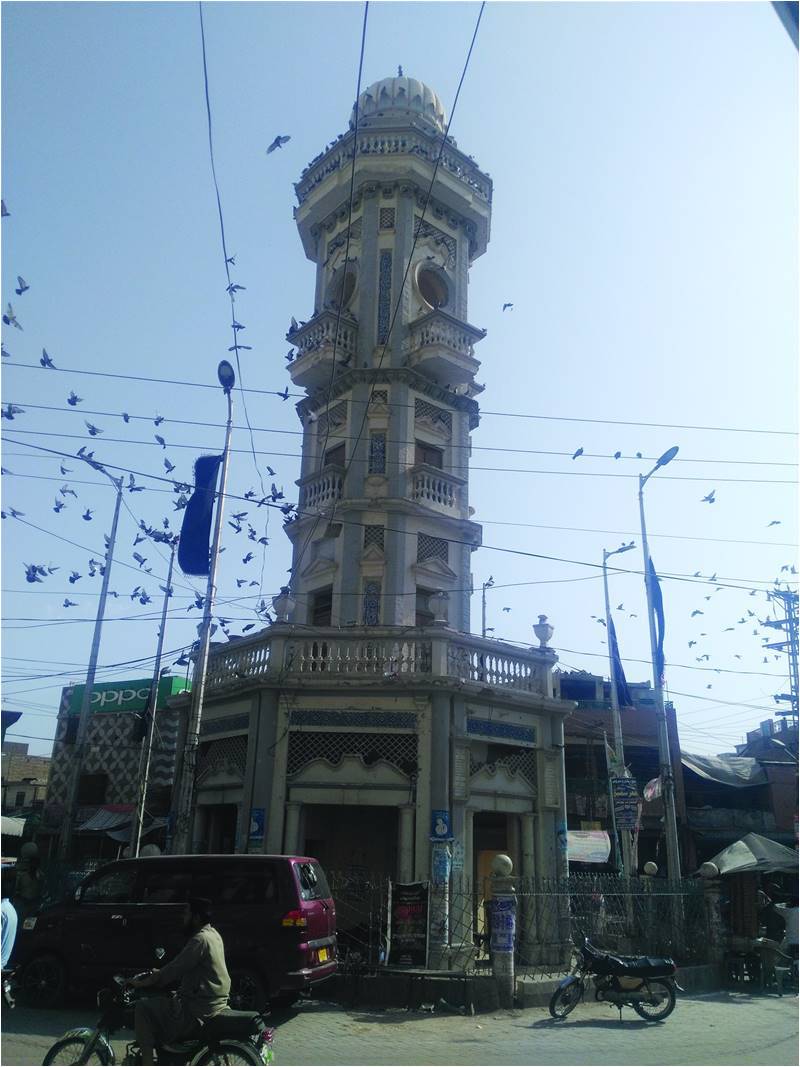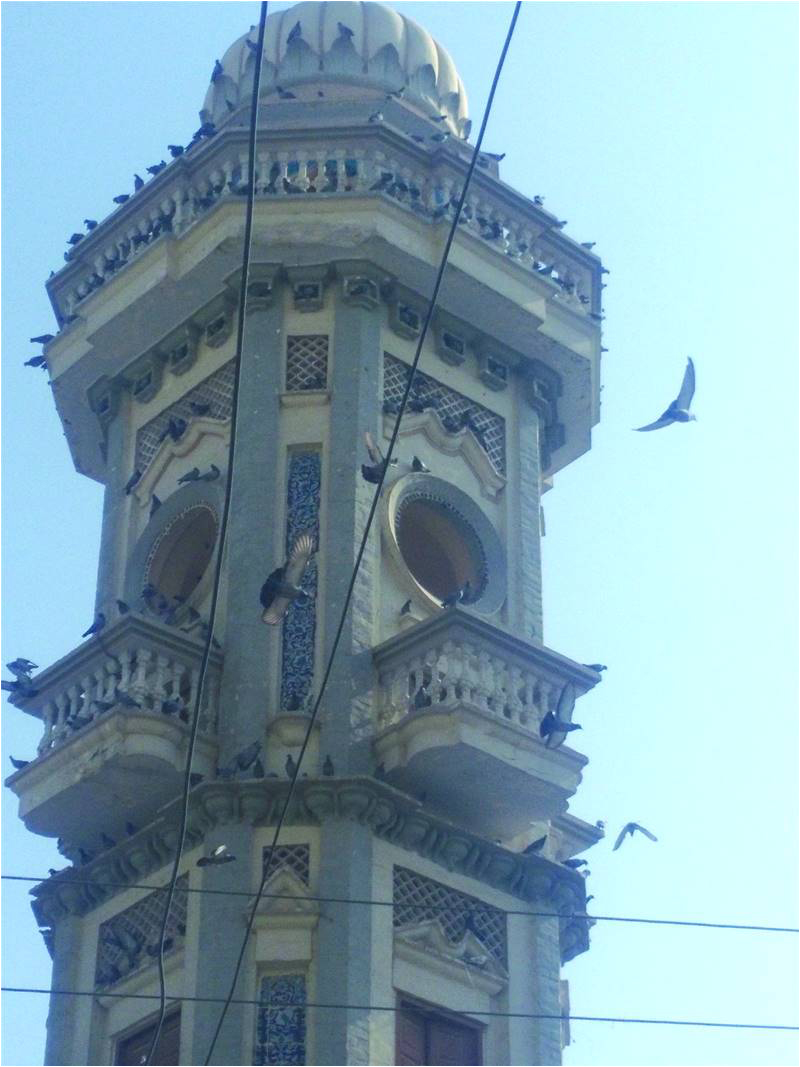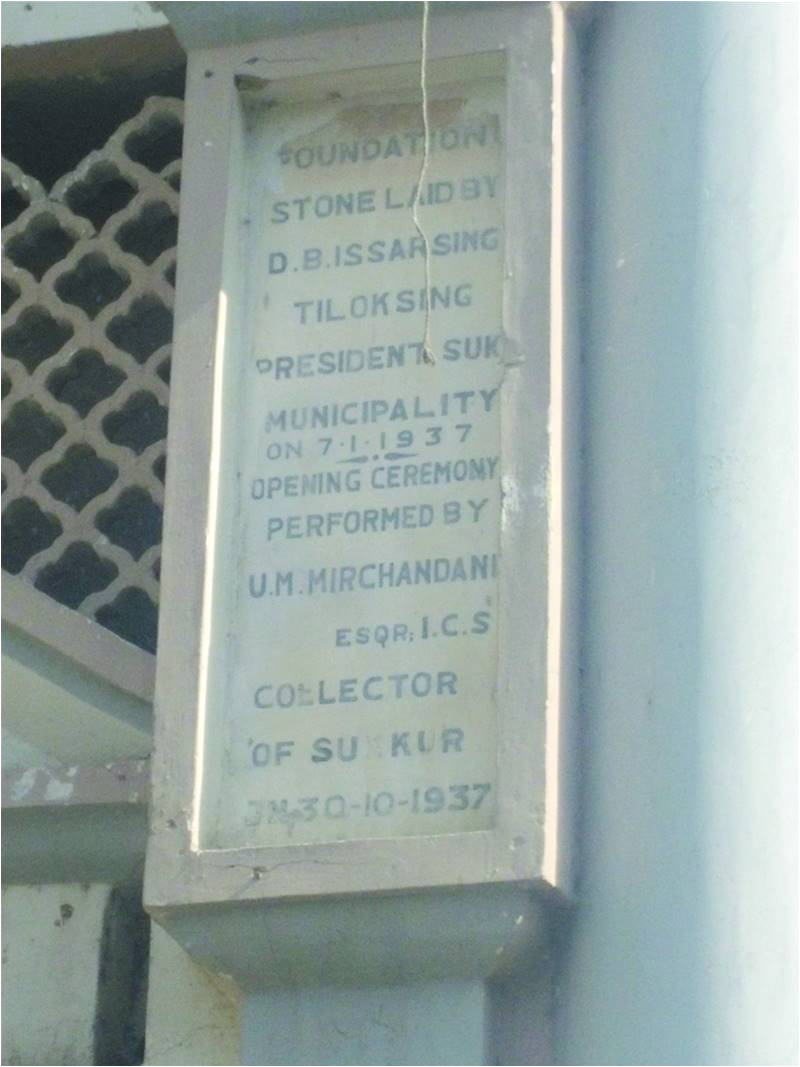
The Ghanta Ghar or clock tower in Sukkur is the pride of the city’s urban landscape. It used to help weary travelers reach their destinations on time since 1937 until 25 years ago – when all four of its clocks were stolen.
“Since then it looks like a gloomy structure, stripped of its beauty”, says Abdul Hameed aka Cheena, who runs a paan shop in the area. “Despite all the atrocities, the landmark still stands tall, begging for the attention of the government officials who have yet to replace the clocks on the tower.”
According to the plate placed at the base of the tower, Ghanta Ghar was inaugurated by the then Sukkur collector UM Mirchandani in 1937. It was a gift to the residents of Sukkur by a Hindu businessman, Seth Wadho Mal Nebhau Mal Manjhari, who built the tower to mark the Silver Jubilee of King George V. Located in the city centre, Ghanta Ghar marked the gateway at which people from other cities and suburbs of Sukkur would gather before entering any of the markets located nearby. The 90-foot-high tower was given its name due to the four clocks that showed the time on all four sides. Until 25 years ago, the clocks would chime at every hour, the sound reverberating throughout the city – especially at night when there was less traffic on the roads.

Ever since its bells stopped clanging, time around Sukkur’s Clock Tower has slowed down. Located smack in the centre of the city, it is surrounded by Victoria Market, Mehran Markaz, hotels and shopping malls.
“Once upon a time, Ghanta Ghar used to stand tall and alone with nothing but Victoria Market for company, but as the time wore on, more and more buildings cropped up”, Cheena tells me. “Some were brought down to be replaced by bigger buildings such as Hafeez Cinema, which was demolished 15 years ago to make room for a high-rise commercial complex, and the Imperial Cinema which was replaced by another plaza.”
Victoria Market, however, continues to stand in solidarity with the tower, still supplying poultry, vegetables and fruits to people in Sukkur and nearby areas.
In the early 1950s, around eight shops were constructed right around Ghanta Ghar – an architectural affront to its colonial-era majesty. With more business and less attention to repair, the clock continued to be worn down. Finally, around 30 years ago, the then municipal corporation of Sukkur decided to take charge. They demolished these shops and carried out the necessary repairs and renovation. An iron fence was put up around the tower to discourage encroachments.
But while the fence managed to keep out shopkeepers and vendors, it was not enough to keep the habitual heroin users back. Not only did addicts smoke up around the clock, they also managed to steal all four clocks of the tower, leaving it vacant and silent! Nobody seemed to care much, though, and despite the lapse of three decades, the empty shell of the clock tower still stands without its clocks and bells. The gaping holes of Ghanta Ghar sometimes appear as if they were complaining about the apathy of the administration, which cares least about the historical landmark.

When all four clocks of the Ghanta Ghar were still present, a local watchmaker Ahmed, whose shop was located nearby, used to take care of the clocks.
Ghanta Ghar has always been at the centre of things. Protests are staged outside it and religious parties host their events there as well. You can find anything from a sewing machine needle to a plasma TV and air conditioners in the area. It has also become a popular eating spot with restaurants and dhabas nearby. The area is famous for many foods, including chicken chargha, dahi barey, gol gapay, fried fish, seekh kabab, tikka, flavoured milk and many other delights.
After the families leave, groups of local political pundits arrive. They while away the hours in armchair discussions over countless cups of tea in and outside hotels and cafes nearby. Sometimes their arguments are so loud that they can be heard from quite far away. Journalists frequent the area too. Sprawled on plastic chairs near the kulfi vendor, this group spends its time talking about the shortcomings of any journalist not present at the gathering! The discussions go on till late night and as long as the talk continues, the Pashtun tea vendors keep their stoves lit.
Ghanta Ghar is not the only clock tower in the city. In 1939, the then collector Kothawala started building another tower opposite the Gulshan Eid Gah at Stadium Road. Construction was completed in 1940. Already 110 feet high, this tower seems to be even taller than the other because it is built on a small hill. So far it still has retained its four clocks but the hands stopped moving a long time ago. At the time of construction Kothawala had named the tower “Educational Tower” but with the passage to time, people started calling it the Pir Ellahi Bux Tower.
“Since then it looks like a gloomy structure, stripped of its beauty”, says Abdul Hameed aka Cheena, who runs a paan shop in the area. “Despite all the atrocities, the landmark still stands tall, begging for the attention of the government officials who have yet to replace the clocks on the tower.”
According to the plate placed at the base of the tower, Ghanta Ghar was inaugurated by the then Sukkur collector UM Mirchandani in 1937. It was a gift to the residents of Sukkur by a Hindu businessman, Seth Wadho Mal Nebhau Mal Manjhari, who built the tower to mark the Silver Jubilee of King George V. Located in the city centre, Ghanta Ghar marked the gateway at which people from other cities and suburbs of Sukkur would gather before entering any of the markets located nearby. The 90-foot-high tower was given its name due to the four clocks that showed the time on all four sides. Until 25 years ago, the clocks would chime at every hour, the sound reverberating throughout the city – especially at night when there was less traffic on the roads.

After the families leave, groups of local political pundits arrive. They while away the hours in armchair discussions over countless cups of tea
Ever since its bells stopped clanging, time around Sukkur’s Clock Tower has slowed down. Located smack in the centre of the city, it is surrounded by Victoria Market, Mehran Markaz, hotels and shopping malls.
“Once upon a time, Ghanta Ghar used to stand tall and alone with nothing but Victoria Market for company, but as the time wore on, more and more buildings cropped up”, Cheena tells me. “Some were brought down to be replaced by bigger buildings such as Hafeez Cinema, which was demolished 15 years ago to make room for a high-rise commercial complex, and the Imperial Cinema which was replaced by another plaza.”
Victoria Market, however, continues to stand in solidarity with the tower, still supplying poultry, vegetables and fruits to people in Sukkur and nearby areas.
In the early 1950s, around eight shops were constructed right around Ghanta Ghar – an architectural affront to its colonial-era majesty. With more business and less attention to repair, the clock continued to be worn down. Finally, around 30 years ago, the then municipal corporation of Sukkur decided to take charge. They demolished these shops and carried out the necessary repairs and renovation. An iron fence was put up around the tower to discourage encroachments.
But while the fence managed to keep out shopkeepers and vendors, it was not enough to keep the habitual heroin users back. Not only did addicts smoke up around the clock, they also managed to steal all four clocks of the tower, leaving it vacant and silent! Nobody seemed to care much, though, and despite the lapse of three decades, the empty shell of the clock tower still stands without its clocks and bells. The gaping holes of Ghanta Ghar sometimes appear as if they were complaining about the apathy of the administration, which cares least about the historical landmark.

When all four clocks of the Ghanta Ghar were still present, a local watchmaker Ahmed, whose shop was located nearby, used to take care of the clocks.
Ghanta Ghar has always been at the centre of things. Protests are staged outside it and religious parties host their events there as well. You can find anything from a sewing machine needle to a plasma TV and air conditioners in the area. It has also become a popular eating spot with restaurants and dhabas nearby. The area is famous for many foods, including chicken chargha, dahi barey, gol gapay, fried fish, seekh kabab, tikka, flavoured milk and many other delights.
After the families leave, groups of local political pundits arrive. They while away the hours in armchair discussions over countless cups of tea in and outside hotels and cafes nearby. Sometimes their arguments are so loud that they can be heard from quite far away. Journalists frequent the area too. Sprawled on plastic chairs near the kulfi vendor, this group spends its time talking about the shortcomings of any journalist not present at the gathering! The discussions go on till late night and as long as the talk continues, the Pashtun tea vendors keep their stoves lit.
Ghanta Ghar is not the only clock tower in the city. In 1939, the then collector Kothawala started building another tower opposite the Gulshan Eid Gah at Stadium Road. Construction was completed in 1940. Already 110 feet high, this tower seems to be even taller than the other because it is built on a small hill. So far it still has retained its four clocks but the hands stopped moving a long time ago. At the time of construction Kothawala had named the tower “Educational Tower” but with the passage to time, people started calling it the Pir Ellahi Bux Tower.

